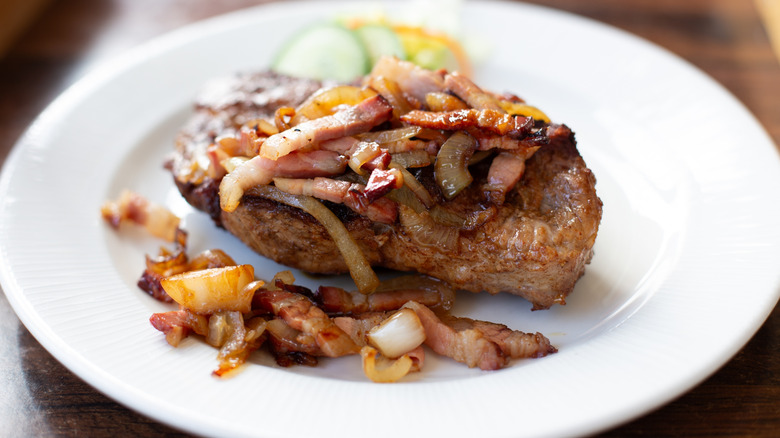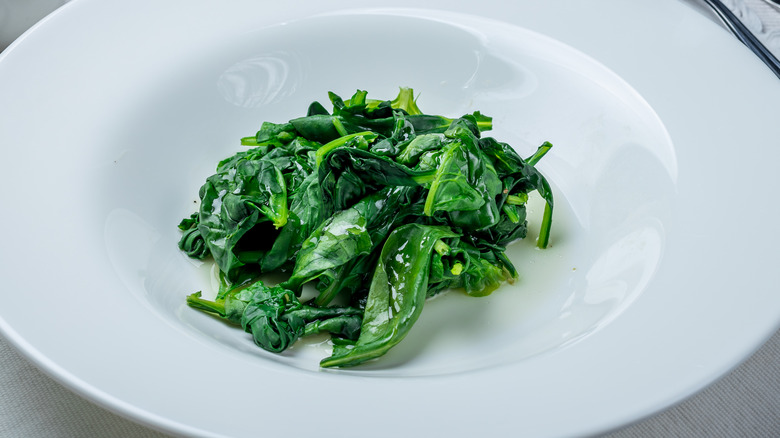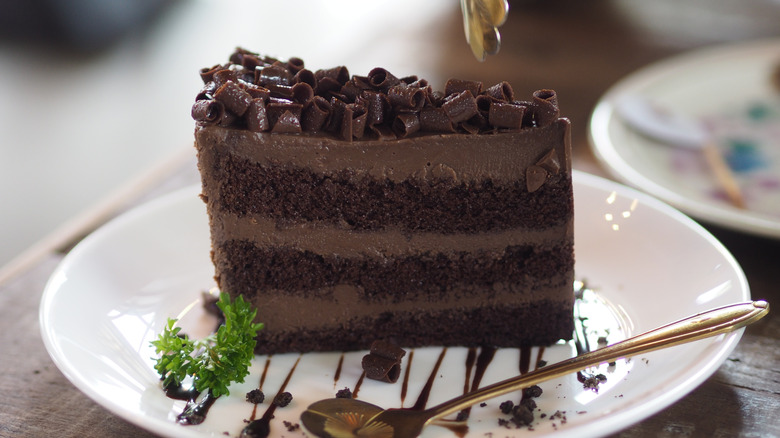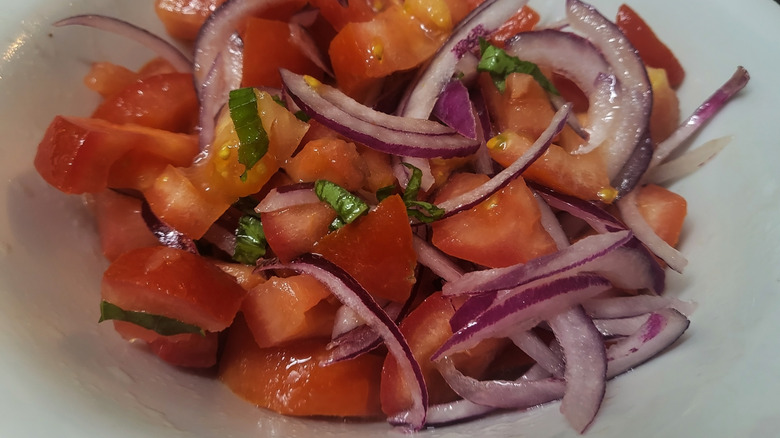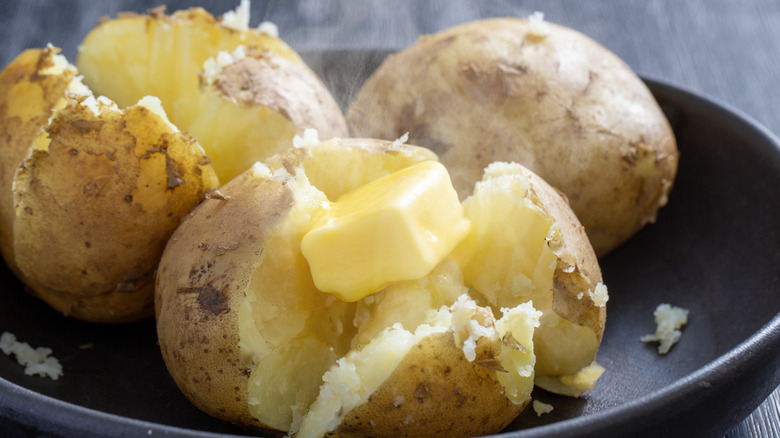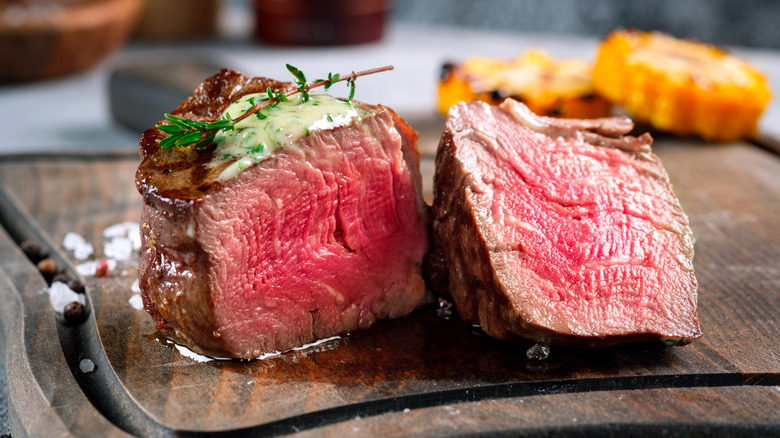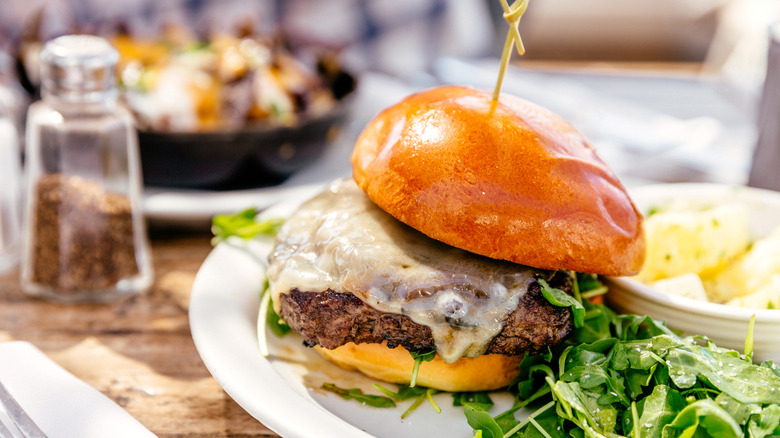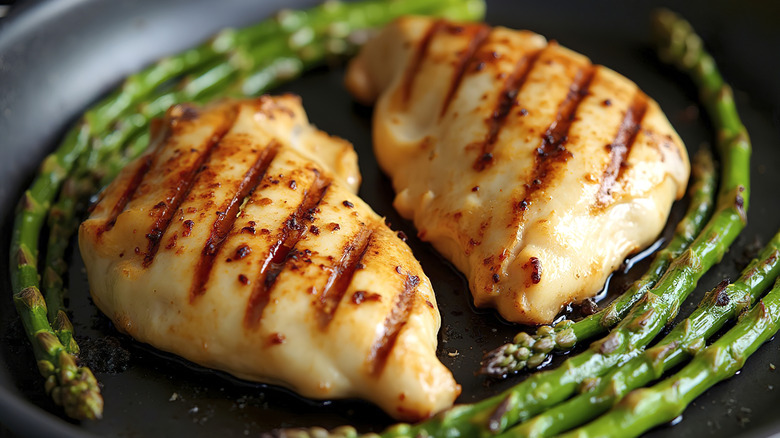Steakhouse Orders Not Worth The Price
A lot of the time, eating at a steakhouse is gonna cost you a lot of money. Sure, you can get a decently priced steak at somewhere like Sizzler or Texas Roadhouse, but in most places you're looking at dropping up to $150 per head on premium beef, vintage wines, and a bevy of delicious grilled sides. The problem is that you may be spending way more than you need to. Steakhouses may feel like the ultimate in fine dining, but these restaurants have a canny way of pricing some of their items to be way more expensive than they have any right to be — and hoping that their customers don't notice that they're spending more than they should.
In some cases, you can figure out which steakhouse orders aren't worth the price by considering base cost. Why, for example, would you pay almost $20 for a side like steamed spinach or baked potatoes if the ingredients would normally cost just a few bucks? In other situations, steakhouse orders can be a little more elusive as to why they cost more than they should, with items like seared tuna and filet mignon setting you back at the expense of sheer quality. Let's check out which items you should avoid if you want to save your money.
Steamed spinach
Steamed spinach can be a godsend during a meal at a steakhouse. The offerings at these restaurants are infamously rich and heavy, and sometimes, a light serving of delicately wilted greens is just what the palate needs to refresh things. The problem is that so many steakhouses charge a lot of money for what is essentially a plate of greens. At Mastro's, for instance, a serving of steamed spinach costs $16, which feels extortionate for what it is — especially when you consider the fact that a bag of fresh spinach costs roughly $2 in a supermarket. Sure, you're paying for the ambience, but not exactly the skill: How much work does it take to steam?
Instead of falling prey to such a massive markup, try and pick vegetable side dishes that you couldn't make at home, or else ones that contain ingredients that justify the expense. Sautéed or creamed spinach costs the same amount at Mastro's, and for the price you're getting more flavor and more work put into the dish. You can also grab sautéed broccolini or asparagus from the restaurant for the same cost, both of which will give you more bang for your buck.
Dessert
There's nothing like a good dessert to finish off a meal, but at steakhouses you're not getting what you pay for. The problem with ordering a dessert at a steakhouse is that it's usually the least considered part of the meal. While steakhouse chefs spend years perfecting how to cook the perfect ribeye or tomahawk steak, when it comes to dessert, they're often "buying cakes from a store, cutting them, and putting them on a plate," according to Delmonico's owner Dennis Turcinovic for Business Insider. Some of these cakes can cost $20 per serving, which is a lot to pay on top of an already expensive meal.
This isn't the case with all steakhouses, of course — but unless the one you're dining in is offering bespoke desserts or specifically has a chef who specializes in them, it's pretty likely. It's especially common at chain steakhouse restaurants, which of course have to keep their operations streamlined and cost-effective. So, why would you pay top dollar for something that's arrived at the steakhouse in a tub, instead of being made fresh? If you want our advice, we recommend saving your money, skipping the dessert, and then heading somewhere else for a sweet treat after. It's a great way to extend your evening, you get to try two places in one night, and you'll likely find something a little cheaper than at the steakhouse you were just at.
Seared tuna
If you're not in the mood for beef, seared tuna can feel like a good alternative. The fish has a meatiness to it that allows it to still hold its own in a steakhouse and with their traditional sides, and searing it gives it a smoky quality that can somewhat rival steak. However, the sad fact is that a lot of steakhouse chefs just don't know how to treat this protein. They can end up searing all of the moisture out of the fish, leaving you with a dry, tasteless portion of food that's not worth the price you're paying for it.
Plus, that price is a lot, guys. At Smith & Wollensky, seared yellowfin tuna costs $52 – marginally cheaper than its most affordable steak, but way more expensive than a lot of other entrées. Don't be tempted to order it as sashimi, either. Although this can sometimes turn out okay, if you're not in a restaurant that has a dedicated sushi chef, it can end up a real disaster. We'd always recommend saving raw tuna for top-quality sushi restaurants, and seared tuna steak for restaurants that specialize in fish more generally.
Shrimp cocktail
Few foods have been criticized as much as shrimp cocktails, and unfortunately, we're about to throw more fuel onto the fire. Shrimp cocktails have had a bit of a renaissance of late: This vintage appetizer was once ridiculed for being a kitschy relic of the '60s, but nowadays it feels somehow cool again. Unfortunately, steakhouses are capitalizing on this resurgence and charging a pretty penny for the privilege of ordering them. Shrimp cocktails can now cost upwards of $30 and nudge towards $40 in some steak restaurants.
So where does this inflated price come from? The cost of shrimp has been rising steadily in recent years, and when you combine this with restaurants seeking out the biggest and best shrimps available, the bill can add up. However, even with this in mind, some steakhouses really push things to the limit. Order a shrimp cocktail in a steakhouse today, and you can end up with four or five shrimp sitting on a bed of sauce, and each bite costs you more than five dollars. You have to wonder whether that's really worth it, especially considering that you can make shrimp cocktail at home for just a few bucks.
Tomato and onion salad
Tomatoes and onions are famously inexpensive, but that doesn't stop steakhouses from charging you top dollar for them. This refreshing salad can cost more than $15 in some steak restaurants, and while many tomato and onion salads come with additional ingredients that help to justify their cost, there's still a bit of a conundrum as to why they're so expensive. Additionally, tomatoes are especially susceptible to changes in their flavor and quality when out of season — and unless you're opting for this salad at peak times, you may end up paying a lot of money for not that much flavor.
As such, if you're ordering a tomato and onion salad between the months of May and October, you might end up with a good plate of food. Any other time of the year, though, this salad is best avoided. It also might be worth thinking about the general flavor profile of your meal. Steakhouse dishes tend to go heavy on onion and tomato tastes anyway, and so ordering a salad that also has them can make your experience a little samey. You might just want to go for a simple green salad, which is often cheaper than its tomato- and onion-based sibling.
Baked potato
A combo of steak and a baked potato is top-tier, folks. However, we'd recommend enjoying this duo at home, instead of at a steakhouse. While baked potatoes are a reliable choice at steakhouses, especially when you're overwhelmed by the options on offer, they can be wildly overpriced for what you actually get. At Mastro's, for example, a twice-baked potato is priced at $16. We get that you might be paying for the work that goes into making it, the ambience of the restaurant, and (we guess) the cost of the oven heating that 'tater up twice, but let's be real: This is wildly expensive, especially when you consider that potatoes cost less than a dollar each.
Rather than burn all your money on a simple potato, we'd recommend opting for spud dishes that have more costly ingredients that you wouldn't find at home. Options like truffle fries or potatoes au gratin will give you more bang for your buck, being options that are typically too cumbersome to make yourself. This same rule applies to simple mashed potato dishes, too: Unless there's more going on than just potato and butter, you should avoid paying top dollar.
Filet mignon
Filet mignon is one of the safest choices you can make in a steakhouse. Not only is it a cut that most people are familiar with, but it's also generally the cheapest steak on the menu. As such, it's an attractive option for folks who don't feel like experimenting, but unfortunately, it's a steak that can often leave a lot to be desired. Chefs routinely complain that filet mignon has a one-dimensional, flat flavor and a lack of tenderness. It may be cooked well in steakhouses, but when the person in the kitchen is limited by the composition of the beef itself, there's not a lot they can do. Plus, filet mignon may be relatively affordable compared to other steaks, but it's still expensive: At Alexander's Steakhouse, a filet mignon costs $71.
Furthermore, Delmonico's owner Dennis Turcinovic states that filet mignon is an unadventurous choice, and one that you can get pretty much anywhere. Instead, wouldn't you want your steakhouse experience to be a little more exciting? "In my world, that would mean more like a ribeye or larger ribeye, like a Tomahawk steak, what they would call côte de boeuf," he states. Listen to the experts, and go for the interesting option.
Wedge salad
The wedge salad has to be the most divisive thing on a steakhouse menu. Some people love them, some people hate them – but regardless of where you stand, you can probably agree that they're overpriced. Think about it: You're basically paying for a corner of lettuce that costs mere pennies, a couple of extras sprinkled on top, and a blue cheese dressing. Is that really worth forking out $20 or more for? We really don't think so.
Plus, you have to consider what the actual experience of eating a wedge salad will be, once you get past the nostalgic, retro feel of it. The dressing is often poorly distributed, leaving you with a huge clump of it on top of the lettuce and not a lot elsewhere. The lardons and additional ingredients, meanwhile, tumble off the lettuce and pool around the bottom, making enjoying each flavor in one bite difficult. It may be a visually impressive thing to order, but you'll likely find that you feel that your money's been wasted.
Burgers
Look, we love burgers. Everyone does. However, we don't love them at steakhouses. In fact, we kinda don't love them at restaurants in general: They tend to be overblown, fussy, and weirdly boring creations that go for maximalism over balance. However, at steakhouses this sort of goes to the extreme, with chefs trying to push for the biggest burger possible to rival their steaks, leaving you with a massive mound of food that has no nuance.
Oh, and you'll pay a lot for the experience. At The Old Homestead Steakhouse, burgers come in at anywhere between $29 and $47. That may be way less than the steaks the restaurant sells, but that's still a lot of money — especially when you consider that you're getting ground beef. To be fair to The Old Homestead, its beef is clearly well-sourced (with a Kobe beef burger that looks pretty cool), but there's no denying that ground beef is a totally different gastronomical experience compared to steak.
Chicken breast
If all else fails in a restaurant, there's always chicken breast — but in a steakhouse, ordering it can be a risky move. The main issue with ordering chicken breast in a steakhouse is that so many places get it wildly wrong. Chicken breasts are frequently overcooked, and just like steak, they don't fare particularly well when this happens. The meat dries out fast, and quickly becomes flavorless. This would be less of an issue if chicken breast dishes were significantly less expensive than steaks, but just check out the price of the roasted chicken breast at The Capital Grille: At $42, it's hardly cheap, right?
Plus, doesn't ordering chicken breast at a steakhouse feel like a contradiction in terms? You go to these restaurants to eat red meat, or at the very least, dark meat. Steakhouses are all about big flavor, and less about delicacy and subtlety. If you want chicken, it's far better to go to a restaurant that specializes in it, so that you know it's cooked properly. Otherwise, we'd stick to beef.
